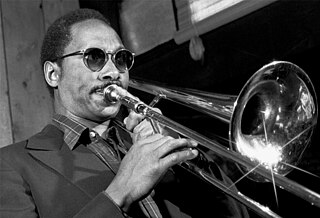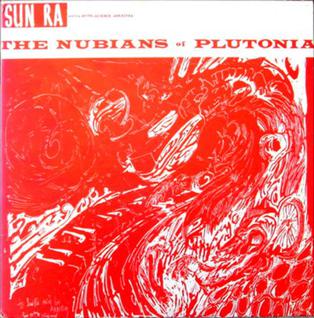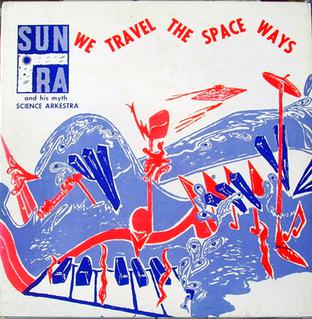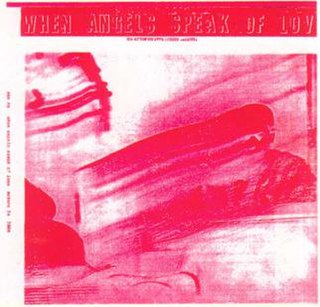Related Research Articles

Le Sony'r Ra, better known as Sun Ra, was an American jazz composer, bandleader, piano and synthesizer player, and poet known for his experimental music, "cosmic" philosophy, prolific output, and theatrical performances. For much of his career, Ra led "The Arkestra", an ensemble with an ever-changing name and flexible line-up.

Julian Priester is an American jazz trombonist. He is sometimes credited "Julian Priester Pepo Mtoto". He has played with Sun Ra, Max Roach, Duke Ellington, John Coltrane, and Herbie Hancock.
Kelan Phil Cohran was a jazz musician. He was best known for playing trumpet in the Sun Ra Arkestra in Chicago from 1959 to 1961, and for his involvement in the foundation of the Association for the Advancement of Creative Musicians (AACM).
Tani Tabbal is a jazz drummer who has worked with Roscoe Mitchell, David Murray, and Cassandra Wilson.
The Sun Ra discography is one of the largest discographies in music history. Jazz keyboardist, bandleader and composer Sun Ra recorded dozens of singles and over one hundred full-length albums, comprising well over 1000 songs, and making him one of the most prolific recording artists of the 20th century.

Hypnotic Brass Ensemble is an eight-piece, Chicago-based brass ensemble consisting of eight sons of the jazz trumpeter Phil Cohran. Their musical style ranges from hip hop to jazz to funk and rock, including calypso and gypsy music. They call their eclectic blend of sound "now music", or "Hypnotic". Reared in the teachings of music since they were children, they grew up on the stage playing as the "Phil Cohran Youth Ensemble".

Angels and Demons at Play is a jazz album by Sun Ra and his Myth Science Arkestra.
On the Beach may refer to:

Featuring Pharoah Sanders and Black Harold is a jazz album by Sun Ra, recorded live in 1964, but not released until 1976, on Ra and Alton Abraham's El Saturn label.

The Nubians of Plutonia is an album recorded by Sun Ra and his Myth Science Arkestra c.1958 - 1959 and released c.1966 on his own Saturn label. Originally released in a blank sleeve under the title The Lady With The Golden Stockings, the album had gained its current title, and sleeve by Richard Pedreguera, by 1969. In common with most releases by Sun Ra at the time, the record was printed in extremely limited numbers and primarily available at concerts and mail-order. The record was reissued by Impulse! in 1974, and on CD by Evidence in 1993, backed with the contemporaneous album Angels and Demons at Play.
"The Nubians of Plutonia... evidence an Arkestra moving into ever looser, more abstract ground. The percussion becomes more varied and moves ever closer to the foreground. 'The Golden Lady' seduces with a swaying groove created by a combination of simple parts: hi-hat, cow bell, wood blocks, rolling floor toms and bass. Ra then sets up a dark melodic theme, and then the Arkestra proceeds to weave a series of jaunty, blues-tinged solos into the fabric of the groove. 'Nubia', 'Africa' and 'Aiethopia' continue this excursion into more mystical, rhythm-based territory. The Arkestra utilizes the same ominous, simmering percussion beds, now augmented by more exotic instruments like Pat Patrick's 'space lute', which gives a playfully sinister sound to 'Africa'.... This powerful, multi-faceted music is a great place to start if you are just beginning to travel with Sun Ra, or a great way to continue the journey." Mathew Wuethrich

Interstellar Low Ways is an album recorded by the American jazz musician Sun Ra and his Myth Science Arkestra, mostly recorded in Chicago, 1960, and probably released in 1966 on his own Saturn label. Originally titled Rocket Number Nine, the album had acquired its present name, and the red-on-white sleeve by Claude Dangerfield, by 1969. The album is known particularly for the two songs featuring space chants - Interplanetary Music and Rocket Number Nine Take off for the Planet Venus - that would stay in the Arkestra's repertoire for many years;
'Rocket Number Nine points toward the music that the Arkestra would be playing on the lower East Side of New York City. The tenor sax solo isn't the work of John Coltrane in 1962, but of John Gilmore in 1960. And not even Ornette Coleman's bassists were playing like Ronnie Boykins at this date.' Robert Campbell

Fate in a Pleasant Mood is an album by the American jazz musician Sun Ra and his Myth Science Arkestra recorded in Chicago, mid 1960 and originally released on his own Saturn label in 1965. The album was reissued by Impulse! in 1974, and by Evidence in 1993. For the latter reissue, the record was included as the first half of a CD that also featured the whole of When Sun Comes Out, an album recorded by the Arkestra in New York, 1963.

We Travel the Space Ways is an album by the American jazz musician Sun Ra and his Myth Science Arkestra. Recorded mostly in 1960, the album was released in 1967, on Sun Ra's own label Saturn. The album brings together a number of eras and personnel of the Arkestra, and was probably mostly recorded by Ra himself during rehearsals.

Art Forms of Dimensions Tomorrow is an album by the American jazz musician Sun Ra and his Solar Arkestra. Often considered the first of Ra's 'outside' recordings, the album was the first to make extensive use of a discovery by the Arkestra's drummer and engineer Tommy Hunter:
'Art Forms of Dimensions Tomorrow.... contained "Cluster of Galaxies" and "Solar Drums", two rhythm section exercises with the sound treated with such strange reverberations that they threatened to obliterate the instruments' identity and turn the music into low-budget musique concrète. While testing the tape recorder when the musicians were tuning up one day, Hunter had discovered that if he recorded with the earphones on, he could run a cable from the output jack back into the input on the recorder and produce massive reverberation:
"I wasn't sure what Sun Ra would think of it... I thought he might be mad - but he loved it. It blew his mind! By working the volume of the output on the playback I could control the effect, make it fast or slow, drop it out, or whatever." [Tommy Hunter]
'By the 1950s commercial recording companies had developed a classical style of recording which assured that the recording process itself would be invisible... but Sun Ra began to regularly violate this convention on the Saturn releases by recording live at strange sites, by using feedback, distortion, high delay or reverb, unusual microphone placement, abrupt fades or edits, and any number of other effects or noises which called attention to the recording process. On some recordings you could hear a phone ringing, or someone walking near the microphone. It was a rough style of production, an antistyle, a self-reflexive approach which anticipates both free jazz recording conventions and punk production to come.' John F Szwed

Secrets of the Sun is an album by the American Jazz musician Sun Ra and his Solar Arkestra. The album is considered one of the more accessible recordings from his 'Solar' period. Originally released on Ra's own Saturn label in 1965, the record was unavailable for many years before being reissued on compact disc by Atavistic in 2008.
'Marking a transition in its development between the advanced swing of the early Chicago-era recordings and the increased free-form experimentation of its New York tenure, this album also reveals the first recorded versions of two Ra standards, "Friendly Galaxy" and "Love in Outer Space." Accessible, yet segueing into vanguard territory, this album highlights a fertile period in the Arkestra's history. Looser and more aggressive than its Chicago recordings, these pieces find the Arkestra pushing at the limits of harmony and tonality.' Troy Collins

For the song by Harold Arden and Ted Koehler, see When the Sun Comes Out

When Angels Speak of Love is a music album by the American Jazz musician Sun Ra and his Myth Science Arkestra. Originally released in 1966 on Sun Ra's own Saturn label, the record would have only been available by mail order or sold at Arkestra concerts, and is one of the rarest of all Saturn releases. The record was reissued on compact disc by Evidence in 2000.

Cosmic Tones for Mental Therapy is an album by the American Jazz musician Sun Ra and his Myth Science Arkestra. Recorded in 1963, but not released until 1967 on Sun Ra's own Saturn label, the record has become one of the most discussed of Ra's New York recordings. The record was reissued on compact disc by Evidence in 2000.
'Cosmic Tones functions as a kind of blueprint for the sort of large-scale jazz weirdness that would inform much of Sun-Ra's subsequent works, featuring the woozy reeds of And Otherness and the afro-jazz experiments of Thither And Yon. On Adventure Equation a space echo treatment on the recording which is reprised for the sax flurries on Voice Of Space making the whole experience even more disorientating than it already would be.'

Holiday For Soul Dance is an album by the American jazz musician Sun Ra and his Intergalactic Arkestra recorded in Chicago, mid-1960 and originally released on his own Saturn label in 1970. The album was reissued by Evidence on Compact disc in 1992. Within Ra's catalogue, Holiday For Soul Dance is considered a bit of an oddity as it lacks any tracks written by Sun Ra, although a song written by Phil Cohran, the Arkestra's cornet player, is included. The record is one of a trio of albums recorded between 1959 and 1961, featuring jazz standards, that Ra released in the early 1970s. The others were Sound Sun Pleasure!! and Bad and Beautiful.

Monorails and Satellites, Volumes I & II are two albums of solo piano compositions by the American Jazz musician Sun Ra. Both recorded in 1966, Volume 1 was released in 1968 under the title "Monorails And Satellites" and Volume II was released in 1974 under the title "Monorails & Satellites", both on Sun Ra's own Saturn label. The first volume was reissued on compact disc by Evidence in 1992, whilst the second volume has yet to be reissued. The album showcases Ra's skills as a pianist, which are often compared to Cecil Taylor's;
'Monorails and Satellites, a 1966 solo piano recording, showcases Ra's unique style, which bridges the bluesy architecture of Jelly Roll Morton with the angularity of Monk and Cecil Taylor's ascent beyond traditional structure.'
References
- Sun Ra and his Myth Science Arkestra. Angels and Demons at Play. Saturn SR 9956-2-0/P (between 1963 and 1967); Saturn LP 407; Impulse AS 9245 (1974); Evidence (1993). (Possibly the first recording of an electrified thumb piano.)
- Phil Cohran & The Artistic Heritage Ensemble. On the Beach. Katalyst (2007).
| This article relating to percussion instruments is a stub. You can help Wikipedia by expanding it. |